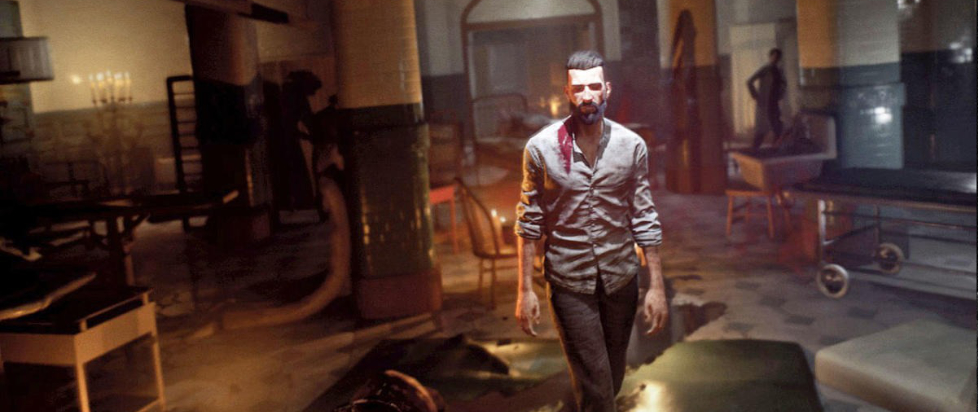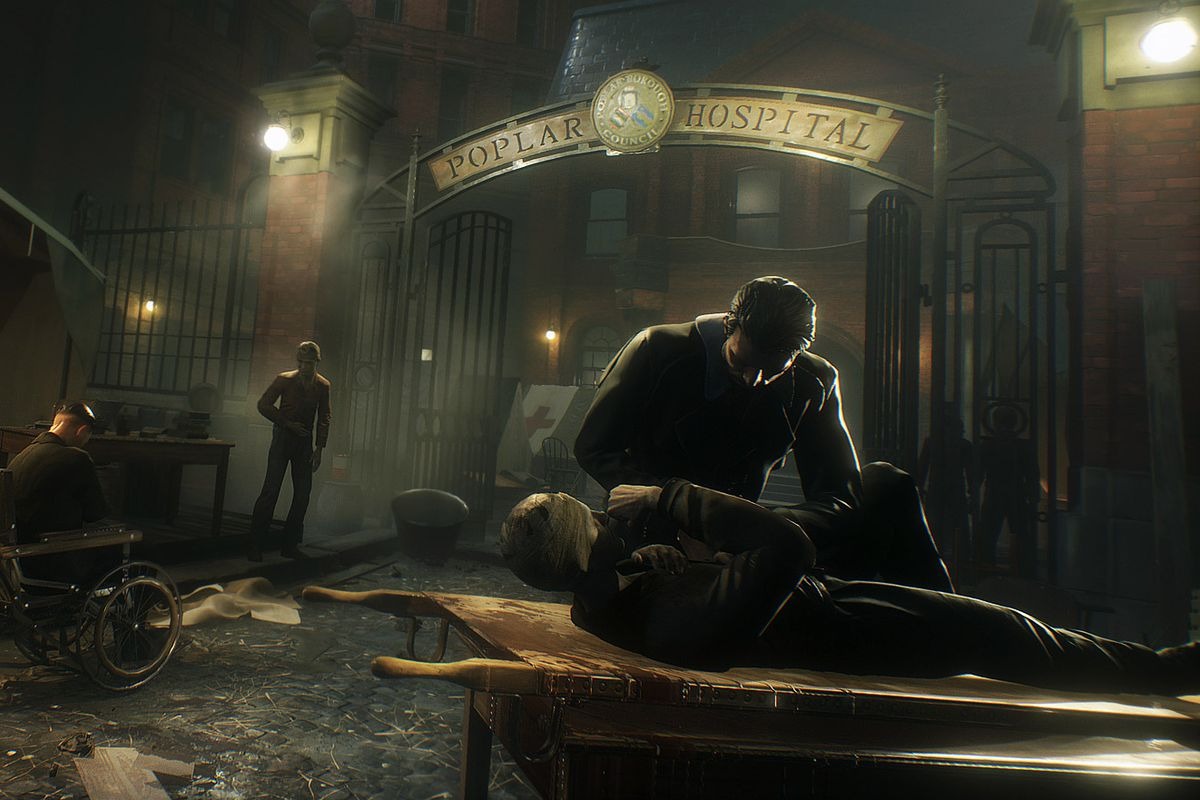
Parasites and Predation

This column is a reprint from Unwinnable Monthly #168. If you like what you see, grab the magazine for less than ten dollars, or subscribe and get all future magazines for half price.
———
Architecture and games.
———
The intersection of architecture and videogames represents a realm where storytelling, aesthetics and player interaction coalesce to form a truly immersive world. In the roleplaying game Vampyr, you’re transported to the gritty, grime-filled streets of postwar London. While the game has been critically acclaimed for its narrative depth and gameplay mechanics, the architectural design is definitely worth a mention, being at once a thematic and functional cornerstone of the game. Let’s dive into the details of the architecture in Vampyr, drawing some connections to the fundamentally parasitic nature of vampires and the questionable mechanics of preying on people for survival. Trust me. There’s more to the level design than you might think.
The architecture in Vampyr is the spitting image of the setting, by which I mean a series of streetscapes marred by war, crippled by a pandemic and plagued by supernatural malevolence. This depiction of London goes beyond mere set dressing or decoration, standing as a testament to the artistry and narrative prowess of the developer, Don’t Nod. Players are thrust into a meticulously reconstructed early twentieth century London adorned with Gothic and Victorian apartment buildings, cobblestone streets and of course eerie, gas-lit alleyways. This dedication to authenticity is a portal for players, dropping them into a time and place teetering on the brink of social collapse.
With all of their soaring spires, intricate embellishments and inherent sense of foreboding, Gothic and Victorian architecture emerge as a dominant visual motif in Vampyr. These elements, combined with nuanced lighting and shadow, saturate the game with an incredibly unnerving and unsettling ambiance which is entirely integral to building an atmosphere of dread and foreboding. The architectural design in Vampyr also transcends the superficial side of level design by actively participating in the narrative. The protagonist and recently reborn vampire Jonathan Reid relies on this architectural layout to unveil secrets, interact with characters and unearth the enigmas underlying the ongoing pandemic. Buildings, winding alleys and concealed passageways become vehicles for storytelling, encouraging you to explore, interact, engage and immerse yourself in the game world.

The theme of parasitism is at the core of the narrative and gameplay experience in Vampyr, plunging players into the moral quagmire of simply existing as a vampire. The symbiotic relationship between architectural design and parasitism offers insight into the nature of predation. Vampires have long been depicted as parasitic beings, draining the lifeblood of the living. The concept is on the other hand elevated in Vampyr, as the very survival of the player hinges on the consumption of human blood. The architectural design seamlessly accommodates this parasitic motif, with an array of shadowy corners, concealed passages and shady corridors that provide players with plenty of opportunities to stealthily hunt and prey upon potentially unwitting passersby.
The architectural elements in the game are ingeniously integrated to heighten the questionable thrill of preying on people. Players can exploit the environment by making use of vantage points, hiding spots and shortcuts to stalk and ambush their next meal. Such a seamless fusion of architecture and gameplay mechanics enhances the overall experience, allowing players to fully adopt their new role as a vampire, along with all of the ethical concerns that accompany the position. Vampyr weaves a tapestry of moral dilemmas, forcing players to grapple with the choice of succumbing to their base instincts or attempting to resist the urge to consume. The consequences of these choices extend beyond the narrative, profoundly impacting the social stability of the city itself, architectural design playing a pivotal role in these decisions. The urban layout and the positions of its people exert considerable influence over the choices made, compelling players to weigh the benefits of predation against the potentially catastrophic destabilization of the community in general.
These mechanics of predation find themselves inexorably linked to the architectural design of the game world. Proficiency in navigating the environment, understanding the routines of the inhabitants and estimating the repercussions of your actions are fundamental to the game. The layout of London is truly labyrinthine, intricately interconnected and replete with diverse districts and buildings. Players have to leverage their knowledge of the environment in Vampyr to hunt potential prey and of course evade pursuers. The architectural design presents not only challenges but also opportunities, encouraging players to strategize and adapt their tactics to the diverse encounters presented throughout the main storyline.

The characters in Vampyr each have a profile complete with personal contacts and connections. Architecture plays a part in this prosopography as their behavior and routine is profoundly influenced by their surroundings. Players must immerse themselves into the lives of their potential victims, gathering insight into their problems and concerns through conversation, investigation and exploratory forays into their living spaces. The action of preying on people in Vampyr is in this way fraught with consequences, not only on a personal level but for the city as a whole. The demise of a specific character can produce a shift in the social structure of the community, changing the behavior of the remaining inhabitants. In other words, the architectural design metamorphoses into a dynamic, responsive entity which reacts to player choice, contributing to the creation of a game world where your actions can have sweeping and sometimes unpredictable consequences.
Vampyr makes use of architecture to shape your experience as a player. The game is built on the assumption that architecture is more than just a background, putting urban planning forward as a means through which narratives are woven, atmospheres are enriched and gameplay mechanics are imbued with meaning. The relationship between architecture, parasitism and the mechanics of survival in Vampyr make the game both intellectually and emotionally resonant. The faithful representation of early twentieth century London, adorned with Gothic and Victorian elements, puts players in a world on the brink of collapse. This architectural authenticity fosters a potent sense of time and place, enriched by the backdrop of social turmoil and ethical ambiguity. The exploration of parasitism, coupled with the mechanics of preying on people, emerges as a profoundly interconnected and functional aspect of the architectural design, as the city itself becomes not just a playground for predation but an instrument of choice, consequence and agency.
Vampyr is a testament to the various ways in which architecture can be used in level design to shape experiences. The game reveals the true potential of architecture to become a tool for the manipulation of mechanics, aesthetics and story in videogames. Tightening the bonds between architecture, parasitism and the mechanics of predation, Vampyr transforms the gameplay experience into an artful exploration of darkness and morality, leaving an indelible imprint on the memory of its players, a black spot which remains marked on your mind long after you put down the controller.
———
Justin Reeve is an archaeologist specializing in architecture, urbanism and spatial theory, but he can frequently be found writing about videogames, too. You can follow him on Twitter @JustinAndyReeve.




